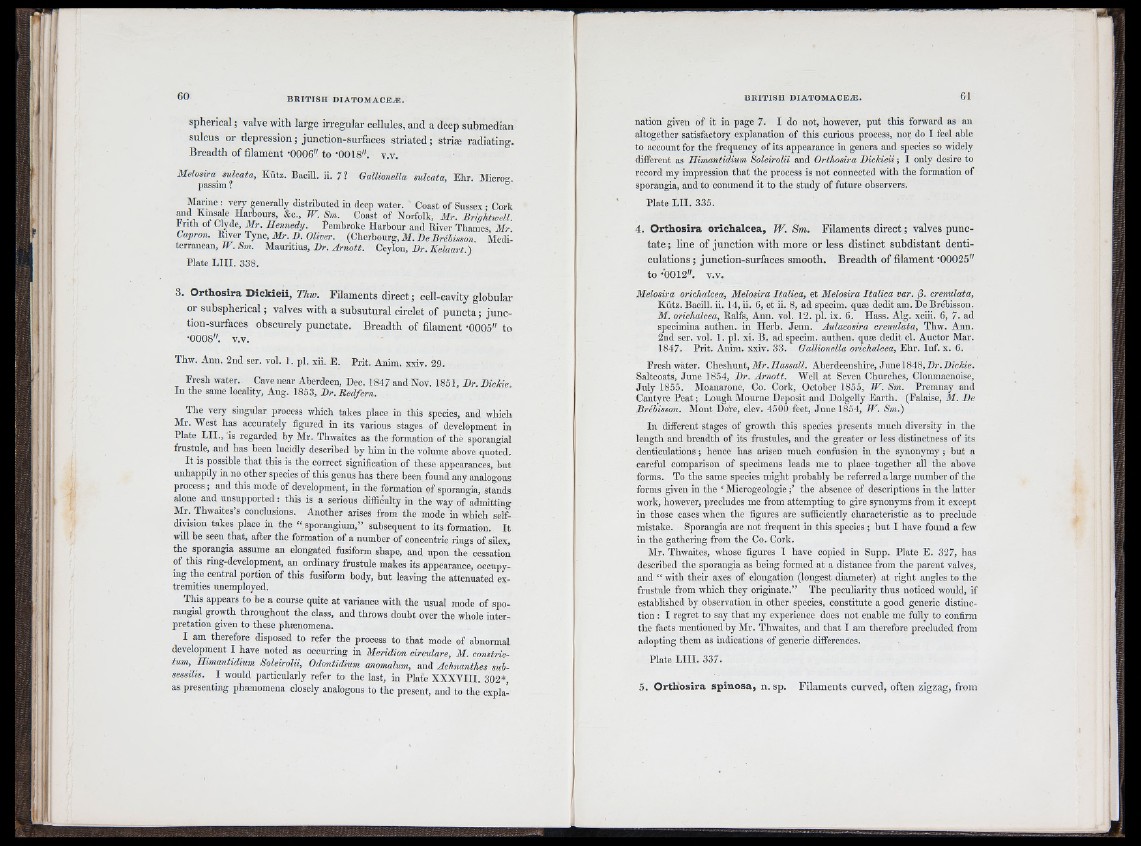
spherical ; valve with large irregular cellules, and a deep submedian
sulcus or depression ; junction-surfaces striated ; striæ radiating.
Breadth of filament -0006" to •0018". v.v.
Mehsira mlmta, Kiitz. Bacill. ii. 7? GalUonella sulcata, Ehr. Micro»-
passim i ®
Miirine : very generally distributed in deep water. Coast of Sussex ; Cork
Coast of Norfolk, Mr. Brightwell.
irith of Clyde, Mr. Hennedy. Pembroke Harbour aud River Thames Mr
Capron. River Tyne, Mr. B. Oliver. (Cherbourg, M. Be Brébisson. Mediterranean,
W.Sm. Mauritius, Hr. Ceylon, Hr./tefom-i:.)
Plate LIII. 338.
3. Orthosira Dickieii, Thw. Filaments direct ; cell-cavity globular
or subspherical ; valves with a subsutural circlet of puncta; junction
surfaces obscurely punctate. Breadth of filament -0005" to
•OOOS". v.v.
Thw. Ann. 2nd ser. vol. 1. pl. xii. E. Prit. Anim. xxiv. 29.
Fresh water. Cave near Aberdeen, Dec. 1847 and Nov. 1851, Hr. Dickie.
Ill the same locality, Aug. 1853, Dr.Redfern.
The very singular process which takes place in this species, and which
Mr. West has accurately figured in its various stages of development in
Plate LII., is regarded by Mr. Thwaites as the formation of the sporangial
frustule, and has been lucidly described by him iu the volume above quoted.
It is possible that this is the correct signification of these appearances, but
unhappily in no other species of this genus has there been found any analogous
process ; and this mode of development, in the formation of sporangia, stands
alone and unsupported : this is a serious difficulty in the way of admitting
Mr. Thwaites’s conclusions. Another arises from the mode in which self-
division takes place in the “ sporangium,” subsequent to its formation. It
will be seen that, after the formation of a number of concentric rings of silex,
the sporangia assume an elongated fusiform shape, and upon the cessation
of this ring-developinent, an ordinary frustule makes its appearance, occupying
the central portion of this fusiform body, but leaving the attenuated extremities
unemployed.
This appears to be a course quite at variance with the usual mode of sporangial
growth throughout the class, and throws doubt over the whole interpretation
given to these phænomena.
I am therefore disposed to refer the process to that mode of abnormal
development I have noted as occurring in Meridion cirmlare, M. constrictum,
Himantidium Soleirolii, Odontidium anomalum, and Achnanthes subsessilis.
I would particularly refer to the last, in Plate XXXVIII. 302*,
as presenting phænomena closely analogous to the present, and to the explanation
given of it in page 7. I do not, however, put this forward as an
altogether satisfactory explanation of this curious process, nor do I feel able
to account for the frequency of its appearance in genera and species so widely
different as Himantidium Soleirolii and Orthosira Dickieii ; I only desire to
record my impression that the process is not connected with the formation of
sporangia, and to commend it to the study of future observers.
Plate LII. 335.
4. Orthosira orichalcea, W. Sm. Filaments direct ; valves punctate
; line of junction with more or less distinct subdistant denticulations
; junction-surfaces smooth. Breadth of filament •00025"
to •0012". v.v.
Melosira orichalcea, Melosira Italica, et Melosira Italiea var. ft. crenulata,
Kütz. Bacill. ii. 14, ii. 6, et ii. 8, ad specim. quæ dedit am. De Brébisson.
M. orichalcea, Ralfs, Ann. vol. 12. pl. ix. 6. Hass. Alg. xciii. 6, 7. ad
specimina authen. in Herb. Jenn. Aulacosira crenulata, Tliw. Ann.
2nd ser. vol. 1. pl. xi. B. ad specim. authen. quæ dedit cl. Auctor Mar.
1847. Prit. Anim. xxiv. 33. GalUonella orichalcea, Ehr. Inf. x. 6.
Fresh water. Cheshunt, Mr. Hassall. Aberdeenshire, June 1848, Dr. Dickie.
Saltcoats, June 1854, Dr. Arnott. Well at Seven Churches, Clonmacnoise,
July 1855. Moanarone, Co. Cork, October 1855, W. Sm. Premnay and
Cantyve Peat ; Lough Mourne Deposit and Dolgelly Earth. (Falaise, M. De
Brébisson. Mont Dore, elev. 4500 feet, June 1854, W. Sm.)
In different stages of growth this species presents much diversity iu the
length and breadth of its frustules, and the greater or less distinctness of its
denticulations ; hence has arisen much confusion in the synonymy ; but a
careful comparison of specimens leads me to place together all the above
forms. To the same species might probably be referred a large number of the
forms given in the ‘ Microgeologie the absence of descriptions in the latter
work, however, precludes me from attempting to give synonyms from it except
in those cases when the figures are sufficiently characteristic as to preclude
mistake. Sporangia are not frequent in this species ; hut I have found a few
in the gathering from the Co. Cork.
Mr. Thwaites, whose figures I have copied in Supp. Plate E. 327, has
described the sporangia as being formed at a distance from the parent valves,
and “ with their axes of elongation (longest diameter) at right angles to the
frustule from which they originate.” The peculiarity thus noticed would, if
established by observation in other species, constitute a good generic distinction
: I regret to say that my experience does not enable me fully to confirm
the facts mentioned by Mr. Thwaites, and that I am therefore precluded from
adopting them as indications of generic differences.
Plate LIII. 337.
5. Orthosira spinosa, n. sp. Filaments curved, often zigzag, from